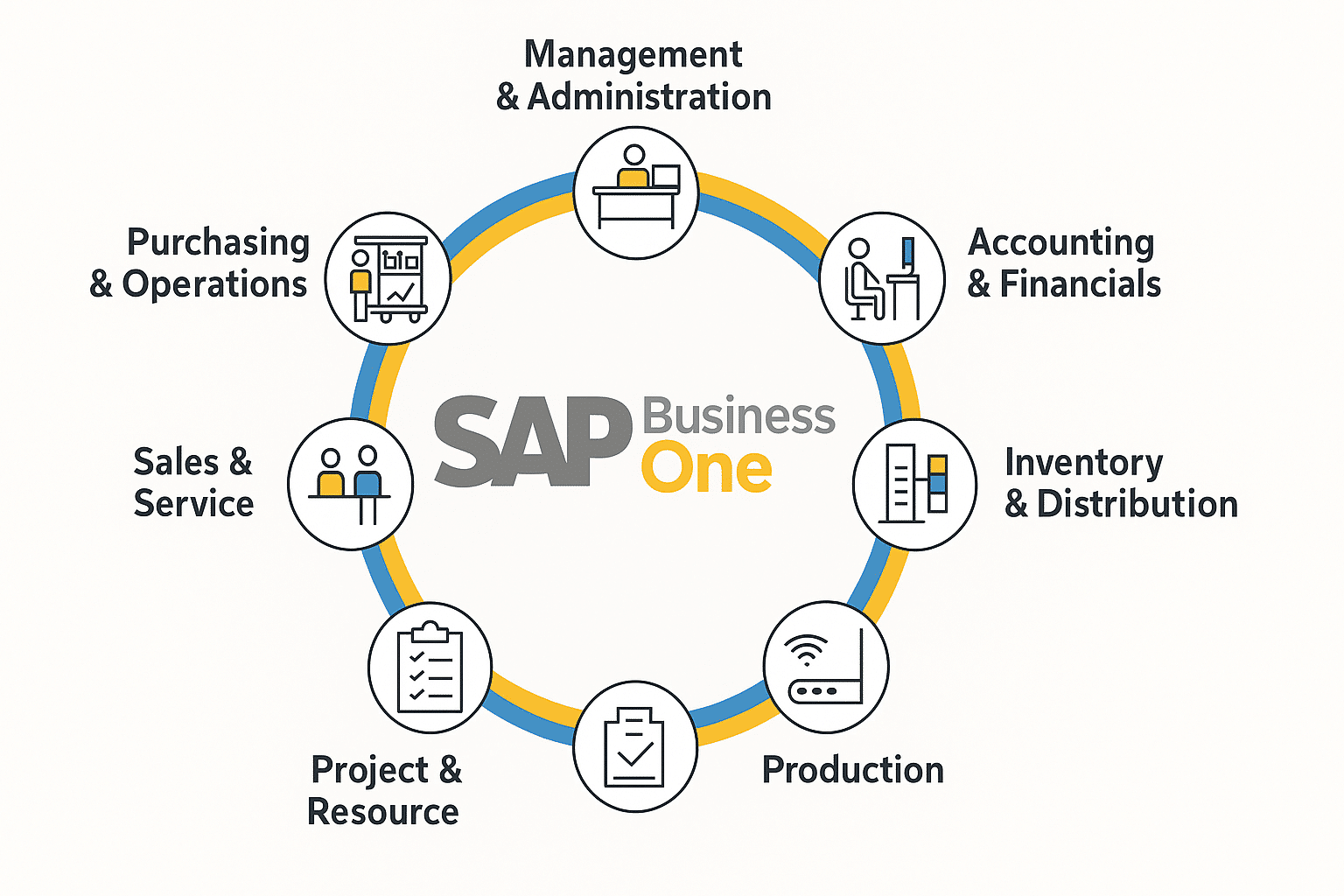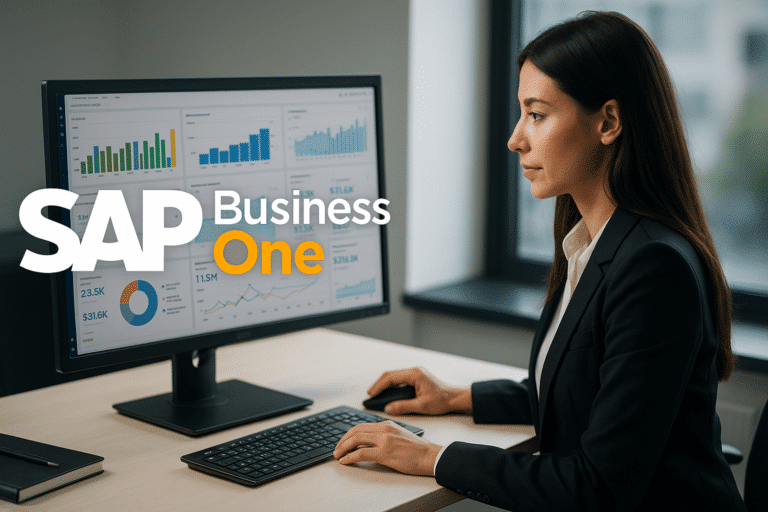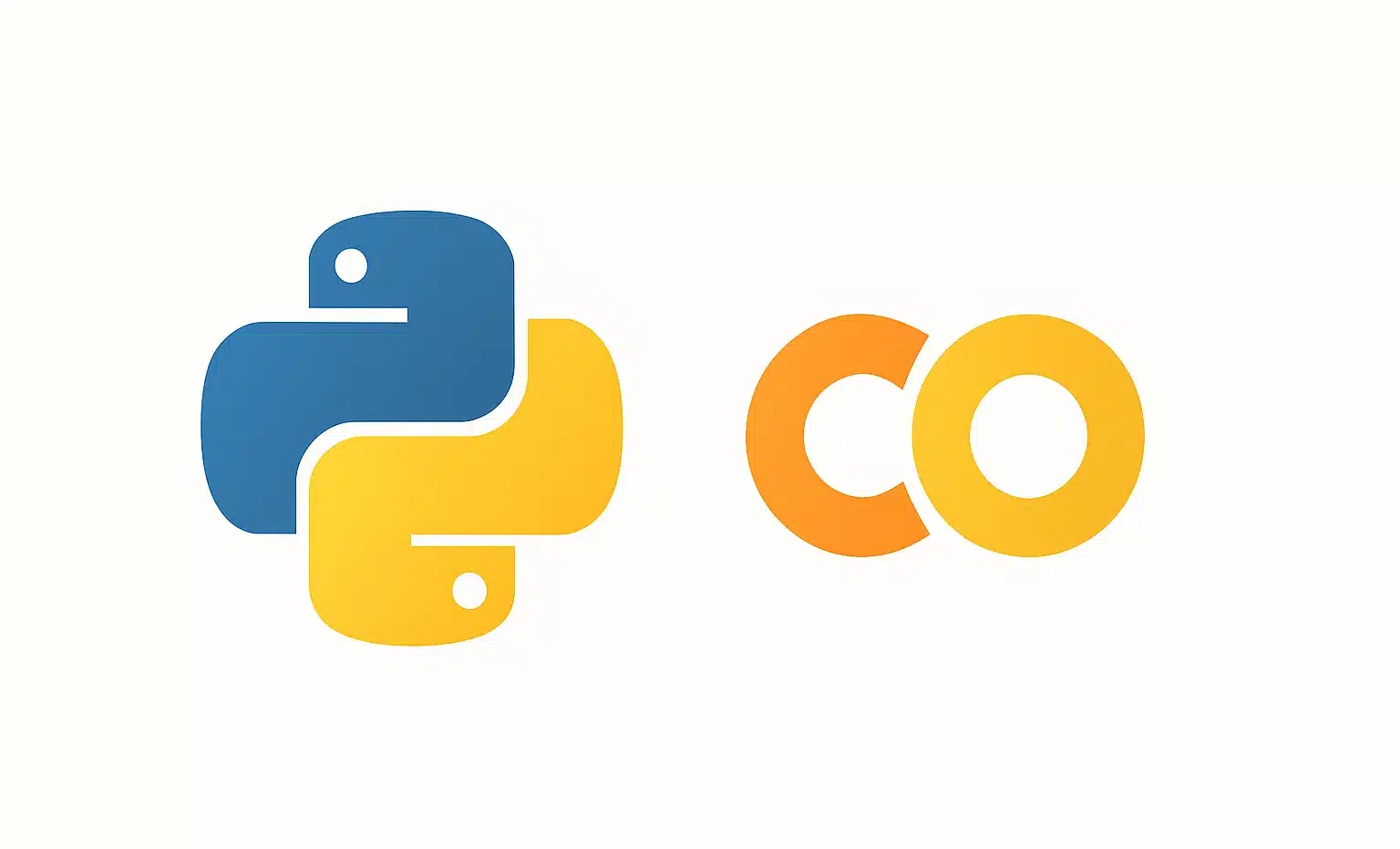SAP Business One is a comprehensive ERP solution specifically designed for small and medium-sized enterprises. It facilitates the efficient management of all your business’s key processes, ranging from accounting to inventory management, while enhancing decision-making capabilities through advanced analytics tools. In this article, discover how SAP Business One can revolutionize your business management by offering robust features and optimal flexibility.
What is SAP Business One?
SAP Business One is an ERP (Enterprise Resource Planning) solution specifically designed by SAP to meet the needs of small and medium-sized enterprises (SMEs). It enables the integrated management of all essential processes within your business, including accounting, sales, purchases, inventory management, and customer relationship management (CRM). This platform, both straightforward and powerful, centralizes all your data into a single system, providing complete visibility over all your operations.
Its user-friendly interface allows you to access accurate, real-time information, thus facilitating well-informed decision-making. Beyond its accessibility, SAP Business One is versatile and can be deployed in cloud mode or on-premise, according to your business preferences. This scalable system adapts to your organization’s growth while integrating advanced Business Intelligence and data analysis features. It serves as a turnkey solution to help you efficiently manage all aspects of your business.

Why choose SAP Business One for your business?
Key Benefits of SAP Business One for SMEs
With SAP Business One, you gain several advantages that will help you optimize your business management.
- All-in-one solution: SAP Business One centralizes all essential functions onto a single platform, simplifying management and preventing the dispersion of information across different tools.
- Adaptability: You can effortlessly customize SAP Business One to meet the specific needs of your business. Whether you are an SME or a branch, this solution perfectly adjusts to your processes.
- Accessibility: SAP Business One is available in cloud mode, offering you great flexibility to manage your business from anywhere while ensuring enhanced security for your data.
- Cost-effectiveness: This solution enables you to achieve savings by optimizing your internal operations. Less time spent on manual tasks means more time for business development.
By choosing SAP Business One, you are opting for a modern solution capable of evolving your business while reducing complexity and optimizing costs.
Performance Improvement Through Automation and AI
SAP Business One integrates automation and artificial intelligence (AI) features that enhance your business’s performance. By automating repetitive and time-consuming tasks, such as inventory management or order tracking, you free up time for higher-value actions. AI, in turn, helps you delve deep into your data to provide relevant management recommendations. These powerful tools make your business more agile and efficient while reducing the risk of human errors.
The automation of your business processes not only saves time but also enhances data consistency and eases its management. By leveraging AI to make decisions based on precise and reliable data, you ensure that you never miss out on opportunities.
Increased Visibility and Data-driven Decision Making
One of the significant strengths of SAP Business One lies in its ability to provide a complete visibility over all your operations. Thanks to Business Intelligence tools and customizable dashboards, you gain valuable insights into your business’s performance. This visibility enables you to make more informed decisions and better anticipate market trends.
Real-time data analysis gives you an undeniable competitive edge. You can respond swiftly to changes, adjust your strategies, and optimize your resources. By relying on accurate data, you not only increase your business’s responsiveness but also enhance decision-making, thereby reducing the likelihood of strategic errors.
Features of SAP Business One
SAP Business One is an ERP solution that centralizes your business’s essential functions. Thanks to its robust features, you can manage all aspects of your organization, from accounting to inventory management, ensuring informed decision-making through precise data. Let’s explore the main features offered by SAP Business One in more detail.
| Feature | Description |
|---|---|
| Accounting and Finance Management | Tracking financial transactions, generating financial reports, and managing customer and supplier accounts in real time. |
| Sales and Purchasing Management | Tracking customer orders, managing contracts, and automating invoicing. Optimizing purchases and supplier management. |
| Inventory and Supply Chain Management | Real-time tracking of inventory, receipts, shipments, and supply management to prevent shortages and optimize costs. |
| Real-Time Reporting and Data Analysis | Business Intelligence tools enabling the creation of detailed reports and dashboards to analyze performance and make informed decisions. |

What is the price of SAP Business One?
Factors Influencing the Price of SAP Business One
The price of SAP Business One can vary greatly based on several factors specific to your business. It is crucial to understand these elements before making a decision. Firstly, the type of license you choose will impact the cost. SAP Business One offers several types of licenses, including for professional users or users with limited access, according to your business’s needs.
The deployment mode you choose (cloud or on-premise) will also affect the price. The cloud version offers advantages in terms of lower initial costs and maintenance included but may involve recurring monthly fees. On the other hand, the on-premise version requires a larger initial investment for infrastructure and ongoing server management.
Another factor to consider is the number of users. The larger your company, the more licenses you will need for your employees, which increases the price. Finally, adding additional modules or customizations specific to your industry can also influence the total solution cost.
Comparing Prices: SAP Business One Cloud vs. On-Premise
The decision between SAP Business One Cloud and the On-Premise version depends on several criteria, including your company’s budget and long-term needs. Here is a summary table to help you better understand the cost differences between these two options:
| Criteria | SAP Business One Cloud | SAP Business One On-Premise |
|---|---|---|
| Initial Cost | Low, no infrastructure to manage | High, need to purchase and maintain servers |
| Maintenance | Included in subscription | To be planned for infrastructure and updates |
| Accessibility | Available remotely, anywhere | Local access, requiring connection to internal server |
| Flexibility | High, possibility to add resources anytime | Moderate, requires manual updates to scale |
| Security | Managed by SAP, data secured in certified data centers | Internal responsibility, requires strict security management |

Conclusion
Your choice between SAP Business One Cloud and the On-Premise version depends on your business priorities. If you are seeking a flexible solution that is accessible remotely with a lower initial cost, the Cloud is an excellent option. Conversely, if you prefer to maintain full control over your data and infrastructure and have the resources to manage this solution, the On-Premise version might be better suited to your needs. Regardless of your decision, SAP Business One offers a powerful and adaptable platform to efficiently manage your business operations.










